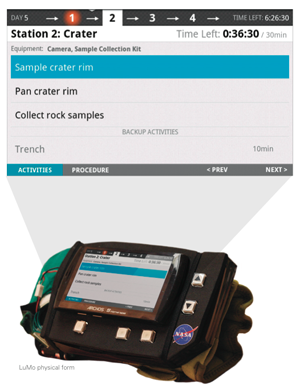Project Background
Summary
Central to any human effort in space is the fluent and reliable execution of technical, operational, and scientific plans by astronauts. From current Shuttle and International Space Station missions to future planetary surface exploration efforts, unique planning challenges call for better tools that enable astronauts to execute complex tasks, often under shifting and unpredictable conditions.
To this end, our interdisciplinary team of five Carnegie Mellon Master of Human-Computer Interac- tion students, working with the Human-Computer Interaction Group at NASA Ames Research Center, has been tasked to design, develop, and evaluate a prototype assisting real-time execution of human space missions.
Final Design
Our final design, Lumina Mobile (LuMo), is a cuff-mounted tool that supports the execution of planned science and operation activities during planetary surface missions. The tool is designed to accommodate the unique needs of astronauts, who must often dynamically re-plan in the face of unforeseen circumstances from complex and time-constrained plans. LuMo allows astro- nauts to view an optimized version of the plan timeline, activities, procedures and execution notes, with timing information indicating how far ahead or behind schedule they are.
The prototype utilizes large physical buttons rather than alternative touch screen input to accommodate the physical constraints of heavy space suit gloves.
The final design of LuMo was inspired by our user research findings, informed by supplementary research on planetary surface missions and evaluated through two Operational Readiness Tests performed in preparation for Landing Day.



